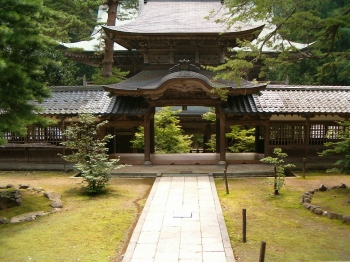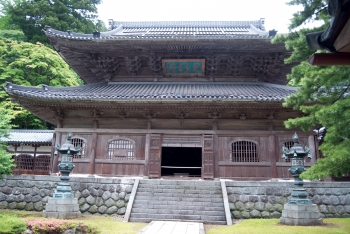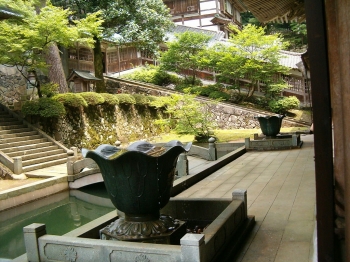 Gate to Eihei-ji. From Supermidget, Wikimedia Commons.
Gate to Eihei-ji. From Supermidget, Wikimedia Commons. Buddha hall at Eihei-ji. From Kstigarbha (sic), Wikimedia Commons.
Buddha hall at Eihei-ji. From Kstigarbha (sic), Wikimedia Commons. Pond at Eihei-ji. From Supermidget, Wikimedia Commons.
Pond at Eihei-ji. From Supermidget, Wikimedia Commons.This is the first of a series of articles on Japanese Buddhism written by Gereon Kopf for Buddhistdoor.
When I was teaching at the University of Hong Kong from 2008–9, I was routinely asked about the role of precepts in Japanese Buddhism. Thus, I thought it would be helpful to have a look at the practice of lay ordination in Soto Zen Buddhism. Together with Rinzai and Obaku, Soto is one of three major traditions of Zen Buddhism in Japan.
As Zen Buddhism slowly entered the English-speaking world in the mid-20th century, Soto was seen as the Zen for the “common people,” focusing only on meditation. While this image is partly rooted in history and doctrine, recent scholarship has proven it to be too simplistic. Today, we know that Soto owes at least some of its popularity to the clever policies of Zen master Gasan (1275–1366) (Tsukuda 2013) and the practice by many temples of distributing medicine (Williams 2005). In addition, the role of the master and lineage remains important to Soto rhetoric and practice.
However, there is some truth to the trope (found in Soto narratives and early Western scholarship) that Soto consciously reaches out to a wider audience. Soto’s founder, Dogen (1200–54), who brought the lineage of the Chinese Caodong master Tiantong Rujing (1163–1228) to Japan, was fond of the rhetoric of simplicity and naturalness even when he sometimes cloaked it in heavy-handed philosophical terminology. One of his basic tenets was that all sentient beings are buddha-nature (rather than possess), and have to actualize or express it in continuous action.
Some versions of the Records of Eihei (Eihei koroku) claim that when Dogen returned from China, he proclaimed nonchalantly, “I did not go to many monasteries, I only studied under Tiantong Rujing. I realized that my eyes are horizontal and my nose is vertical. I was not deceived by anyone. I have come home empty-handed” (Takashi 1980). This phrase is
often interpreted to indicate that Zen teaches “nothing special” (Suzuki 2010, 23) and that only the realization of “things as they are” matters.
The same idea can be found in Dogen’s understanding of the precepts. At the time he returned from China, there was a disagreement among Japanese Zen monastics over the role and number of the precepts. Zen master Eisai (1141–1215), the founder of Rinzai in Japan, supplemented the 250 precepts of the pratimoksha (also referred to as the basic rules of monastic discipline) with the 58 bodhisattva precepts. Dainichibo Nonin (act. 12th century), the founder the Daruma school of Zen (which was absorbed into the Rinzai and Soto schools in the 13th century), was inspired by the Tendai (Japanese form of Tiantai) belief in the formless, “perfect sudden precepts,” and rejected both basic and bodhisattva precepts.
Dogen took the middle path and suggested using 16 precepts—the “three refuges” (“I take refuge in the Buddha, the Dharma, and the Sangha”), the “three pure precepts” (“stopping evil,” “cultivating goodness,” and “benefiting others”), and the “ten great prohibitions.” While Dogen's understanding of the precepts is still seen as authoritative within the Soto tradition, it was subject to much debate in the 17th century, after Obaku had entered and gained popularity in Japan. Today's teaching and practice of the precepts in Soto owes much to the teaching of Menzan Zuiho (1687–1763), emphasizing the oneness of meditation and precepts and maintaining that the ordinand enters the lineage of Shakyamuni and becomes a Buddha at the time of ordination.
The “precept-bestowing assembly,” which is held annually in spring at Eihei-ji, lasts one week and culminates in the ordination administered by the abbot of Eihei-ji. Between one and two hundred lay people from all over Japan gather for the week, and live and practice together in the dharma hall. According to Soto doctrine, deceased family members can also participate in the ordination ceremony by proxy. During the preparation period, the lay ordinands take part in monastic life, practice meditation, participate in the daily ceremony conducted by the monks, and receive teachings. After five days of preparation, lay people and monastics join together to receive the precepts in the ordination ceremony.
The evening before the ordination itself, all the candidates for ordination, including monks, nuns, laymen, and laywomen, participate in a repentance ceremony in which they are reminded that minor transgressions are immeasurable and during which all infractions are symbolically erased by fire. The ordination itself is performed the subsequent evening in the dharma and practice halls. After the ordinands vow to keep the 16 precepts before the whole assembly, they mount the ordination platform in small groups, and then receive their “lineage chart” and a “precept name” one by one (Riggs 2014).
While the lifestyle of the monastics is regulated and formulated differently than that of laypeople, both share the same moral and spiritual commitments. During this special ceremony, monastics and laypeople alike enter into Shakyamuni's lineage and, according to Soto doctrine, actualize their inherent Buddha-nature and “become Buddhas.” In other words, the adherence to the precepts and the practice of meditation constitute the activity of all Buddhas and bodhisattvas. Nothing else is necessary.
Gereon Kopf is professor of religion at Luther College, Iowa, USA.
References
Riggs, David E. 2014. “Are Soto Zen Precepts for Ethical Guidance or Ceremonial Transformation? – Menzan’s Attempted Reforms and Contemporary Practice.” In Dogen and Soto Zen, edited by Steven Heine. Oxford: Oxford University Press (forthcoming).
Suzuki, Shunryu. 2010. Zen Mind, Beginner’s Mind. Boston: Shambhala Publications.
Takashi, James Kodera. 1980. The Formative Years of Dogen in China. New York: Routledge.
Tsukuda, Kazuo. 2013. Gasan zenji monogatari. Sotoshu daihonzan sojiji: Hokkoku shinbun sha.
Williams, Duncan Ryuken. 2005. The Other Side of Zen: A Social History of Soto Zen Buddhism in Tokugawa Japan. Princeton: Princeton University Press.

















